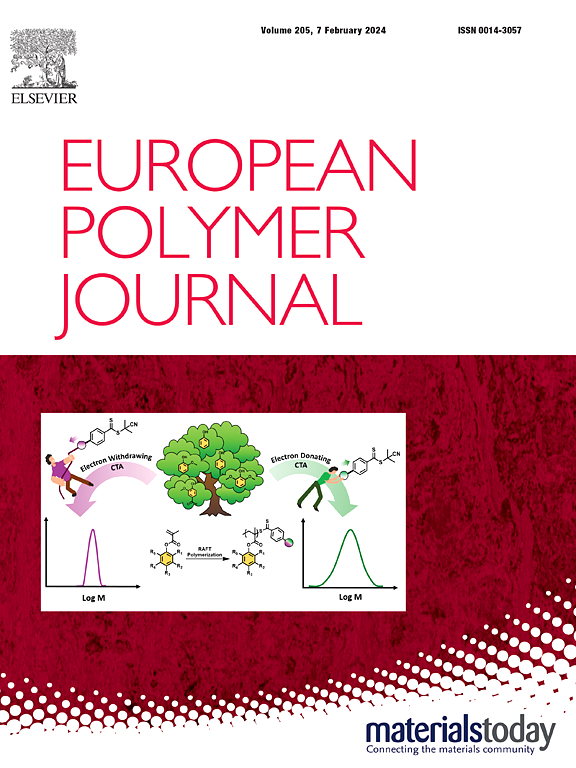Preparation of oxidized hyaluronic acid based antibacterial material and its hydrogel by dynamic imine linkage
IF 5.8
2区 化学
Q1 POLYMER SCIENCE
引用次数: 0
Abstract
Polysaccharide based antibacterial materials have promising application prospects in the field of biomedical materials. However, there are limited types of polysaccharide materials that can balance biocompatibility and antibacterial properties simultaneously. Therefore, the development of highly biocompatible polysaccharide based antibacterial materials is of great significance. In this work, a series of antibacterial materials based on hyaluronic acid (HA)/oxidized hyaluronic acid (OHA) have been conveniently prepared through amide or dynamic imine bonding. The results of antibacterial activity screening showed that the OHA and L-arginine conjugates (OHA-Arg) connected through the dynamic imine bonds possess excellent biocompatibility, and antibacterial activity against S. aureus (MIC = 4 mg/mL). Additionally, the antibacterial hydrogel based on OHA-Arg and 4-arm-poly(ethylene glycol) hydrazide (4-arm-PEG227-Hy) can be prepared through the dynamic crosslinking network based on imine bond and acylhydrazone bond. This work achieved the production of antibacterial materials and its hydrogels based on OHA and QASs/arginine through dynamic covalent bonds, expanded the variety of polysaccharide antibacterial materials, and laid the foundation for the development of new medical dressings.

动态亚胺键合氧化透明质酸抗菌材料及其水凝胶的制备
多糖基抗菌材料在生物医用材料领域具有广阔的应用前景。然而,能够同时平衡生物相容性和抗菌性能的多糖材料种类有限。因此,开发具有高度生物相容性的多糖基抗菌材料具有重要意义。本研究以透明质酸(HA)/氧化透明质酸(OHA)为基础,通过酰胺或动态亚胺键合制备了一系列抗菌材料。抗菌活性筛选结果表明,OHA与l -精氨酸偶联物(OHA- arg)通过动态亚胺键连接,具有良好的生物相容性,对金黄色葡萄球菌具有抗菌活性(MIC = 4 mg/mL)。此外,还可以通过基于亚胺键和酰基腙键的动态交联网络制备基于OHA-Arg和4臂聚乙二醇肼(4臂- peg227 - hy)的抗菌水凝胶。本工作通过动态共价键实现了基于OHA和QASs/精氨酸的抗菌材料及其水凝胶的制备,扩大了多糖抗菌材料的种类,为新型医用敷料的开发奠定了基础。
本文章由计算机程序翻译,如有差异,请以英文原文为准。
求助全文
约1分钟内获得全文
求助全文
来源期刊

European Polymer Journal
化学-高分子科学
CiteScore
9.90
自引率
10.00%
发文量
691
审稿时长
23 days
期刊介绍:
European Polymer Journal is dedicated to publishing work on fundamental and applied polymer chemistry and macromolecular materials. The journal covers all aspects of polymer synthesis, including polymerization mechanisms and chemical functional transformations, with a focus on novel polymers and the relationships between molecular structure and polymer properties. In addition, we welcome submissions on bio-based or renewable polymers, stimuli-responsive systems and polymer bio-hybrids. European Polymer Journal also publishes research on the biomedical application of polymers, including drug delivery and regenerative medicine. The main scope is covered but not limited to the following core research areas:
Polymer synthesis and functionalization
• Novel synthetic routes for polymerization, functional modification, controlled/living polymerization and precision polymers.
Stimuli-responsive polymers
• Including shape memory and self-healing polymers.
Supramolecular polymers and self-assembly
• Molecular recognition and higher order polymer structures.
Renewable and sustainable polymers
• Bio-based, biodegradable and anti-microbial polymers and polymeric bio-nanocomposites.
Polymers at interfaces and surfaces
• Chemistry and engineering of surfaces with biological relevance, including patterning, antifouling polymers and polymers for membrane applications.
Biomedical applications and nanomedicine
• Polymers for regenerative medicine, drug delivery molecular release and gene therapy
The scope of European Polymer Journal no longer includes Polymer Physics.
 求助内容:
求助内容: 应助结果提醒方式:
应助结果提醒方式:


